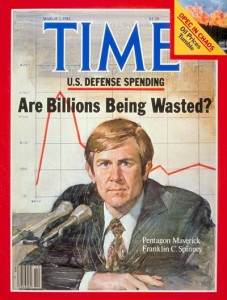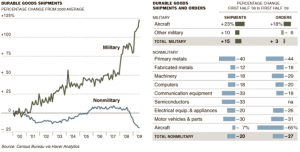
Note to readers: this blaster contains two clearly marked inserts that were not in my Time essay. Also, in introducing Seymour Melman's important work below, I should have mentioned that it was Melman's considered belief in the possibility of putting together a political coalition to facilitate the conversion of the defense industry to civilian production. Conversion is a exceedingly complex and highly controversial subject; and to date, conversion has not been accomplished in any meaningful way, but that does not mean conversion is impossible. Here, that possibility or impossibility is not at issue in this essay; my focus is on the very short term: namely how in the next few months the defense dependency may induce politicians who have been captured by the defense industry to react to the looming budget sequester by flinging the middle class off the fiscal cliff.
Chuck Spinney
By Chuck Spinney, Time (Battleland), Nov. 13, 201
This recent essay – America the Third World Nation in Just 4 Easy Steps – describes how our political addiction to the free-trade ideology of neoliberal economics has helped to de-industrialize America and thereby impoverish much of the American middle class.
My essay describing the decline of manufacturing employment will give you a sense of the mind-boggling magnitude of what has happened. While “4 Easy Steps” makes passing references to the increasing dependence of the manufacturing sector on military spending, as well as the financialization of economy (but not the latter’s Siamese-twin ‘managerialism’), the authors do not develop these points. Without implying any criticism of this excellent essay, my aim today is to tweak your interest in these omissions, particularly America’s defense dependency.
The late Professor Seymour Melman of Columbia University wrote a prescient book, Profits Without Production (Knopf, 1983) that explained how the militarization and managerialization of our economy were becoming the central causes of the decline in America’s manufacturing competitiveness. This decline started in the 1970s, but Melman showed how it grew out of seeds planted by the permanent military mobilization of a huge defense industry in the 1950s.
The birth date for the permanent war economy was 30 September 1950.
On that day, President Harry Truman officially signed NSC-68, a document that became a blueprint for the containment strategy for waging the Cold War. Central to this strategy was the establishment of a large, permanently-mobilized defense manufacturing sector.
They justified the permanent mobilization, in part, with an economic rationalization reflecting their contention that the World War II production miracle proved the multiplier effects of Military Keynesianism, or in their words: “the economic effects of the [NSC-68] program might be to increase the gross national product by more than the amount being absorbed for additional military and foreign assistance purposes.”
The post-WWII economic boom in the U.S. (with our competitive performance aided in part by the lingering effects of the WWII damage to the world’s other major industrial economies) hid the adverse economic effects of the economic diversion attending to the permanent war economy unleashed by NSC-68. Nevertheless, by early 1961, the accumulating damage caused by the diversion was apparent to some insiders: President Eisenhower famously warned the nation about the rise of misplaced power posed by the rise of a large permanent standing arms industry, which he said, pointedly, was new in our national experience.
The accumulating damage wrought by the permanent war economy started to accelerate in the 1970s, and by 1980, the cancer metastasized: militarization and managerialization began to openly thrive at the expense of the traditional high-wage manufacturing sector, in effect, siphoning off money flows via a combination of government handouts and favorable tax treatment that in effect rewarded both the looting of the tax base and the draining of competitiveness and ingenuity from the civilian manufacturing sector (via the increased defense subsidy, leveraged buyouts, offshoring of jobs, emphasizing short-term focus to pump stock prices, etc.)
In America, this evolution has created a weird political situation where a peculiar political darwinism (taking the form of a corporatist alliance of big business and the federal government) co-exists with the neo-liberal ideology of social darwinism. The former stresses mutual dependency and subsidies for survival and the latter stresses individuality and survival of the fittest in a Hobbesian universe. Yet the contradiction between the two modes of thought does not impede the ideologues who promoted both and continue to engage in the looting and draining operations.
That cognitive dissonance is now poised to grow much worse, if as is likely, the government moves in the coming months to impose neoliberal austerity economics on the middle class, while government becomes more embedded with and protects the banksters, the defense contractors, and other corporatist allies. That is because the only way to do social and political darwinism at the same time is to fling what is left of the middle class off the fiscal cliff by defunding Social Security, Medicare, infrastructure modernization, education, etc.
Much has been written on the economic distortions created by the financialization of the economy, but aside from Melman’s pioneering work, little has been written on economic distortions created by the increasing dependency of the manufacturing sector on military spending — which is really a huge government subsidy — and the rise of managerialism. Both sets of distortions

The graphic below provides a hint — but only a hint — of how the hidden distortions that have been insensibly seeping into the U.S. manufacturing sector since the late 1950s (i.e., what Eisenhower sensed and warned about in his 1961 farewell address): it illustrates how rates of growth in the industrial shipments of military durable goods increased at a much faster rate than shipments of nonmilitary durable goods since 2000.
This difference in growth rates reflects the effects of the huge increases in the defense budget since 1998. These difference have worked to increase the disproportionate share of the de-industrializing manufacturing economy that has been soaked up by the defense industry over time. For example, defense spending (base budget + war costs) in 2011-12 amounted to about 4.4% of the gross domestic product. About one-quarter of this spending was applied to the salaries of military and civil servants. That implies the other three-quarters or about 3.3% of GDP was spent on defense goods and services in the private sector. Yet this 3.3% of GDP spent on defense goods and services soaked up 11 to 12% of America’s total capital goods shipments over the last two years.
There are other indicators of the economic distortion caused by the defense dependency: 55% of the federal R&D budget is now allocated to defense-related activities. In the early to mid 1990s, nationwide employment of scientists and engineers in the defense sector soaked up about 30% of the total scientific and engineering employment (public and private sectors). Given the rapid growth in the defense budget and the decline in the manufacturing share of GDP since then, the ratio is likely to be even higher today. Unfortunately, there is little current academic research aimed at understanding the size and meaning of these hugely important preemptions of resources, production capabilities, and skills.
Indeed, most contemporary economists, like the authors of NSC-68, still think of military spending in Keynesian terms as a general economic stimulus and job creator. But Military Keynesianism, if it ever worked, is not working in the 21st Century.
To wit: the largest sustained increases in the defense budget since the end of WWII began in 1998, but this spending binge was accompanied by (1) a sluggish recovery between 2001 and the onset of the Great Recession that began in late 2008 and (2) an acceleration in the rate of decline of employment in the manufacturing sector after 1998 (see Figure 2 here). There is also academic research suggesting defense spending is one of the least effective way to create jobs via government expenditures (see this University of Massachusetts study, for example).
[Unpublished insert #1: Nevertheless, lest you think the NSC-68's faith in Military Keynesianism is ancient history, President Bush was still spouting its soothing nostrums as recently as February 2008, when he told NBC's Ann Curry, “I think actually, the spending on the war might help with jobs. … because we're buying equipment, and people
Defense companies now make up a very substantial part of America’s much diminished industrial base — and these companies are hooked on the narcotic of defense spending.
That is to say, defense manufacturers cannot survive without the defense subsidy. Since the end of the Vietnam War, many have tried to convert some of their efforts to competitive production of non-defense goods, and most have failed. As Melman explained in the early 1980s, these companies simply do not have the marketing, managing, engineering, and manufacturing skills to compete successfully in global commercial markets. By 1990, even the industrial leaders in the Military-Industrial-
This isn’t surprising. Defense industry management teams generally have little commercial experience and market savvy. Most have been ‘cost plus’ and ‘mil spec’ trained. In short, most don’t bring a competitive advantage to non-defense businesses. Frankly, sword makers don’t make good and affordable plowshares.
[Unpublished insert #2: see Why Boeing is Imploding for an unrelated example of how the the defense-related engineering and production practices have spilled over to infect Boeing's civilian production practices.]
On the other hand, Anders did not mention that the defense industry is very skilled in lobbying the federal government to increase their public subsidy for making their unaffordable weapons. Nor did he mention that you buy what you subsidize, and in a ‘cost-plus,’ ‘mil-spec’ed,’ single-buyer economy, you subsidize cost growth.
Anders made his amazing admission in the 1991 keynote address to the twelfth annual conference sponsored by Defense Week, then a very influential newsletter in the MICC. His intent was to explain why, given the end of the Cold War, General Dynamics had chosen not to diversify its business into the non-defense sector. Instead, Anders proposed to undertake a takeover strategy to increase its market share in a (temporarily, as it turned out) shrinking defense market.
Anders was not alone in thinking along these lines. In fact, his speech was a precursor to the industry-wide, government-subsidized “Pac-Man” consolidation strategy. This strategy was promoted by President Bill Clinton’s then-deputy secretary of defense, William Perry, at a 1993 meeting with the defense titans, a meeting dubbed the “Last Supper.” Perry’s strategy led to a rash of industry-wide mergers in the early to mid-1990s.
Significantly, when the defense budget began to grow rapidly after 1998, there was no undoing of the consolidation, even though the rising defense budgets eventually grew to levels exceeding the highest budgets of the Cold War. Today, the defense industry is dominated by three giant all-purpose weapons manufacturers—two of which now have their headquarters in the Washington, D.C., area, and the third (Boeing) with a major government relations office in the area as well—to more closely supervise their most important corporate activity: the lobbying efforts that influence the money flow out of the Pentagon, Congress, and the White House. Together with the banksters, these immensely powerful companies, their smaller brethren, and the huge supporting cast of gucci-shoed K Street lobbyists, pro-defense think tanks, and the defense trade press are poised to pounce on President Obama and Congress to protect their fiscal honey pot, while the rest of country is heaved over the fiscal cliff.
If you want to learn more about the important but little examined subject of defense dependency, and by extension, learn more about why America is becoming a third world nation, the best introduction is Melman’s* elegantly argued 11-page prologue to Profits Without Production, aptly titled ”How the Yankees Lost Their Know-how.”
If that essay does not pique your interest in this hugely important subject, nothing will. Unfortunately, you will have to go a used bookseller to find it.
* Caveat emptor: Melman was my friend and I made some minuscule contributions to the research in this book.



